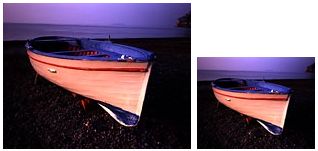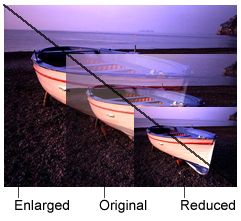|
|
|
|
|
|
|
|
|
©
2000, 2001, 2002, 2003 McInnis & Associates 310 Sixth Street,
Greenport, NY (631) 477-2505 www.ads-on-line.com. For online
use only. Reproduction is punishable under US and international
copyright laws. Purchase the printable document here. |
|
|
|
|
|
Note:
this is a sample page from Lesson 3: Ad Layout. This particular
page teaches salespeople a few basics about scaling artwork.
|
|
Scaling
artwork
|
|
Here's
something else to think about. When you're gathering up the
artwork that the client has given you and you are sitting
down to create the layout, you really need to have an idea
of how that artwork will fit into the ad.
Remember that you need to keep in mind how the artwork will
look when it's either enlarged or reduced to fit in ad, so
you need to make sure that your original artwork will scale
proportionally to fit in the space you've designated. Here's
what you need to know:
Proportional
scaling
Proportional scaling
is when both the width and the depth of the artwork are reduced
or enlarged by the same percentage. This is usually easily
done by the artists on their computer systems although some
use a copy machine with reduction capabilities.
|
 |
|
|
|
|
An
example of proportional scaling. Very good. |
|
|
|
Anamorphic
scaling
Anamorphic scaling
is when the width and depth of the artwork is scaled by different
percentages. For example, you may think it's a good idea to
make the image long and narrow down one side of the ad, however,
if the image you're working with is not long and narrow to
begin with, then this could severely distort the image. Imagine
a standard 3x5 or 4x6 photo of your family or friends. Now
imagine trying to squeeze that image to fit into a space 1
inch wide by 10 inches deep. The figures in the photo would
stretch so much that they would be unrecognizable to you.
The same theory applies to photos of the advertisers products.
So when you're sketching out your layout for an ad, keep these
things in mind and be sure that the space you've indicated
for the artwork will accommodate it as well. |
 |
|
|
|
|
|
An
example of anamorphic scaling. Very, very, bad. |
|
|
|
|
How
will my artwork scale?
Here's an easy way to see what dimensions
your artwork would naturally fit into. See the
scaling diagrams on the right. First make a copy of the original
artwork and set the original aside in a safe place. Using
the copy only, draw a line from one corner to the corner diagonally
across from it. Then by drawing a horizontal line and a vertical
line from any one point on the diagonal line, you will see
a box that the artwork could be scaled to fit into proportionally.
You can then use this sheet as a guide for drawing the area
on your layout sheet and the artists will be able to see exactly
where and how big you would like the artwork to appear.
|
| Determining
how your artwork will scale proportionately:
Illustrated
at right is an easy way to see how your artwork will
scale.
1.
Make a copy of your original artwork. Set the original
aside.
2.
Using the copy only, draw a line between the two diagonal
corners.
3.
Draw a horizontal and vertical line from any one point
on the diagonal and you'll have a scaled version of
the original. |
 |
|
 |
 |
|
 |
 |
 |
 |
 |
 |
 |
 |
 |